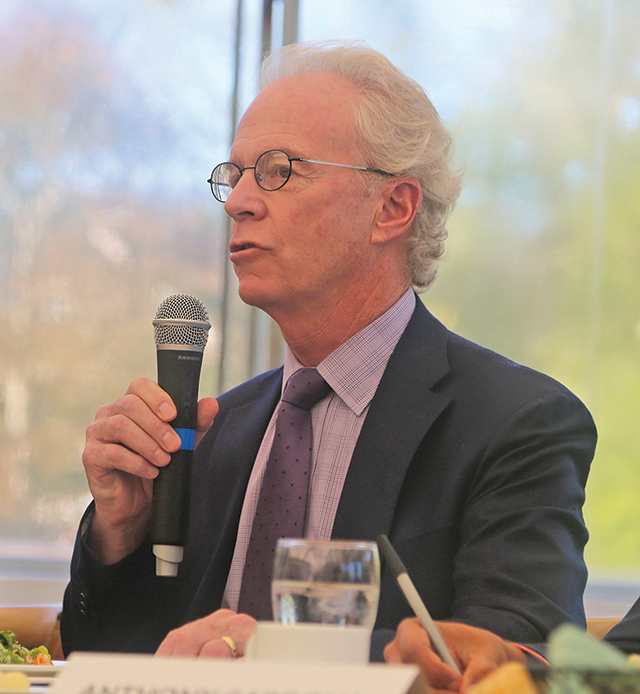At Stony Brook ELIH, conditions can change minute to minute

On March 8, when Suffolk County’s first coronavirus case was confirmed, Stony Brook Eastern Long Island Hospital chief administrator officer Paul Connor made sure his hospital’s emergency management plan was up and running and prepared for what would come next.
But, as boxer Mike Tyson once said, “Everybody has a plan until they get punched in the mouth.”
And Stony Brook ELIH got punched in the mouth — just like every hospital across the region and particularly those in New York City, where, in Elmhurst, Queens, 13 COVID-19 patients died in a single night last week.
“We started our emergency plan just 30 days ago,” Mr. Connor said Tuesday. “That’s when we recognized that this could be a potential problem. Now, after all that’s happened, it seems like 30 months ago and not 30 days.”
As both a hospital administrator and a member of the Greenport community, Mr. Connor essentially resides in two vastly different worlds. In the hospital, conditions can change by the minute. Staffing issues have to be resolved quickly; staff has to be redeployed from one area of the facility to another when the need suddenly arises and extraordinary safety precautions have to be taken so as not to make the situation worse and spread the virus to staff members and their families.
“Yet, when I am out in the community or going to the food store, it’s so completely different,” he said. “It’s just so highly unusual. Then I come in here to make sure we have enough [personal protective equipment], the staff we need, and dealing with all the ever-changing variables — that’s a whole different world.
“Inside, with our very dedicated staff, we are living out that very different world. It’s just stunning. When this first happened, I could not imagine where we’d be just a few weeks later. Now, looking back, I can’t imagine something like this happening so quickly.

“It’s taken our country by surprise,” he adds. “While we are managing, while my colleagues may be worried about supply items, we still keep coming back to deal with the situation. And it is so different each day, people are hesitant to say it will be better tomorrow. I can’t tell you about tomorrow or even the next shift. And all of this in just three weeks. I wake up in the morning and I realize it’s not a nightmare.”
Looking back on the implementation of the emergency plan, Mr. Connor sees areas they could have hardly predicted. One is staffing of critical positions.
“We are a small hospital,” he said. “We don’t have a deep bench. Larger hospitals have residents and interns they can redeploy. We don’t have that luxury. We are fortunate we got personnel in here earlier and, as this goes on, we will be looking for some more.”
He said in times of crisis, hospitals rely on agency personnel — professionals like nurses and supervisors who can be hired and quickly brought to the facility in need of added staff. He said staffing is, in many ways, a more critical issue than if a hospital has enough personal protective equipment.
“It’s better to have your own employees,” he said. “Agency personnel have to be trained, although typically they are well experienced. They go through a vetting process. But it’s also very expensive.”
He said some agencies routinely charged $85 an hour for experienced professionals when a hospital calls. Now, he said, some are charging up to $155 an hour. “Now you are talking big, big numbers,” he said. “You might want to complain, but we really need these people.”
An example of an agency nurse who traveled to Greenport?
“We have a guy living in his RV on the property,” Connor said, adding that — as of Wednesday — he’s brought in eight agency personnel to assist at Stony Brook ELIH.
So what began 30 days ago at level one — the lowest emergency planning level — is today level four. At that level, he said, the hospital can shuffle and redeploy where the need is the greatest — move a nurse from one area, such as elective surgery, to another area where the need has spiked.
To further illustrate the hour-to-hour changes the pandemic has brought, he said that on Monday their COVID-19 cases shot up. “While for a while we had a moderate number, it spiked in one day. That is the new normal,” he said.
“We had a number of patients in psychiatry who experienced symptoms. We tested them. We now have three positives in our hospital and nine people under observation. That’s more than we had two days ago.”
Another area of great concern now, a month into this monster: staff burnout.
“We are trying very hard to better manage our staff to prevent them from just burning out,” he said. “We have to really watch that and put in practices to prevent it. And I want to stress every time I talk about our place how we have an incredible group of employees. And we want to protect them.”








